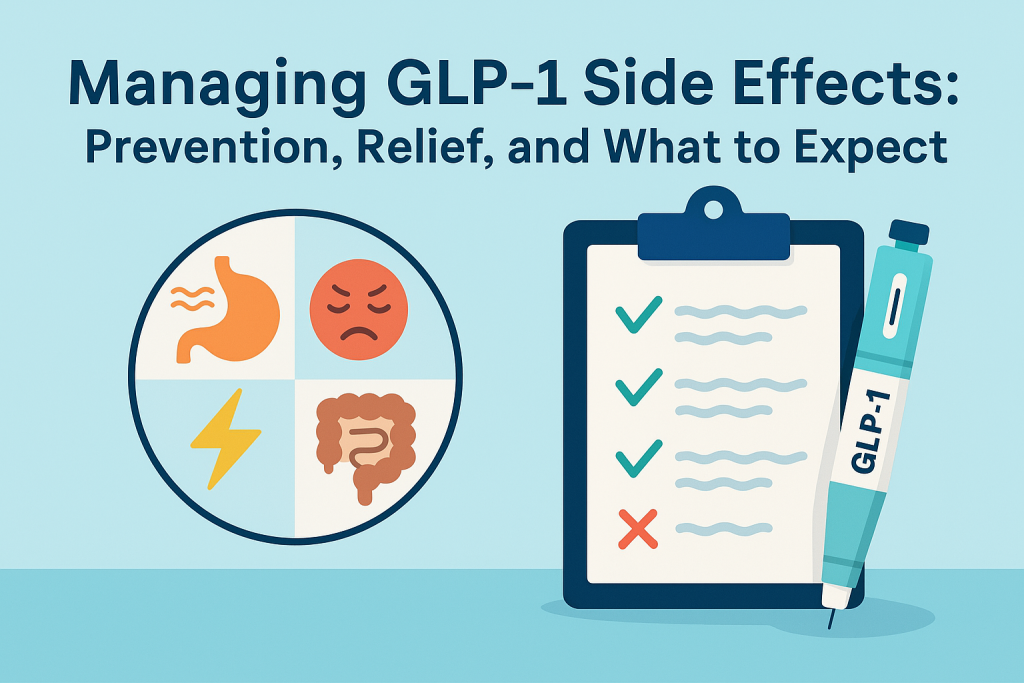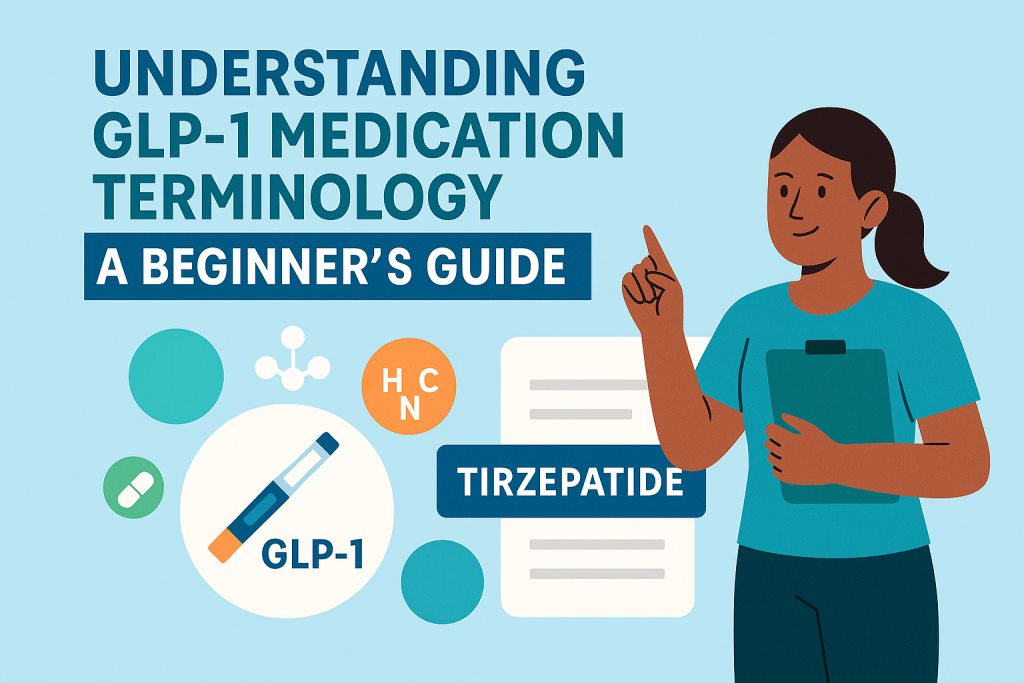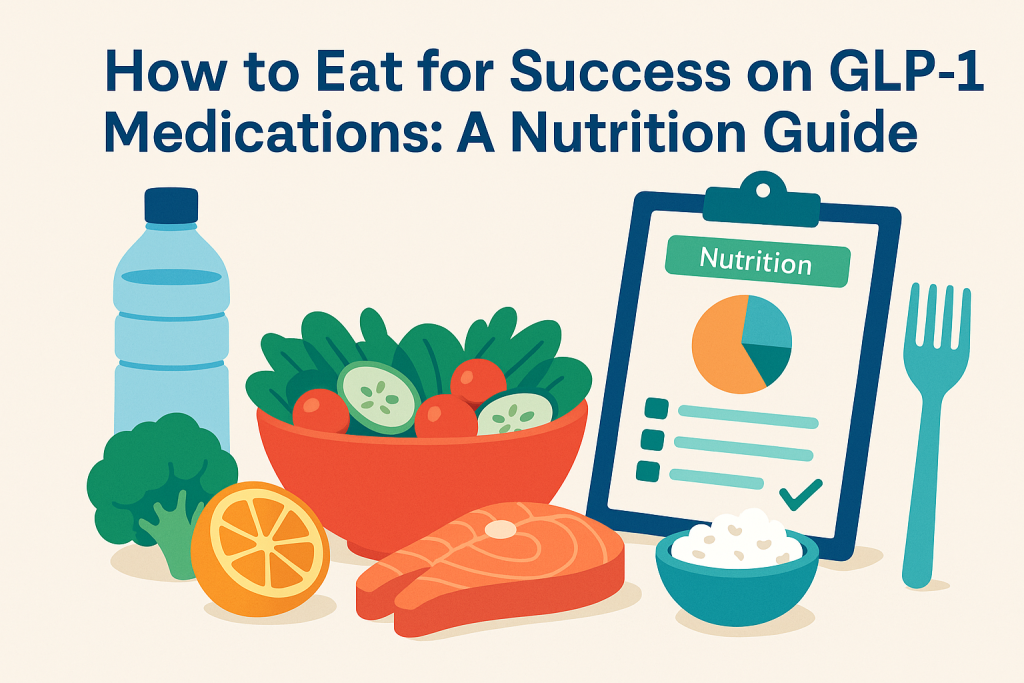- Introduction: Why Understanding GLP-1 Side Effects Matters
- Common GLP-1 Side Effects
- Rare but Serious GLP-1 Side Effects
- Tips for Preventing and Minimizing Discomfort
- What to Do if GLP-1 Side Effects Get Worse
- The Role of Hydration, Meal Timing, and Portion Sizes
- Why Tracking GLP-1 Side Effects Helps—and How Pep Makes It Easy
- When to Talk to Your Doctor
- Myth-Busting Section
- FAQ and Call to Action to Download Pep
- Further Reading
Introduction: Why Understanding GLP-1 Side Effects Matters
When starting any new medication, understanding potential side effects is essential to ensuring a comfortable, safe, and effective treatment journey. GLP-1 medications such as Ozempic, Wegovy, Semaglutide, and Mounjaro are highly effective treatments for managing type 2 diabetes and promoting significant weight loss. They have dramatically improved health outcomes and quality of life for countless individuals. However, like all medications, they come with their own set of potential side effects. Being knowledgeable about these side effects not only prepares you to manage them proactively but also helps you set realistic expectations and maintain consistent adherence to your prescribed treatment.
Managing side effects effectively can significantly influence the overall success of your treatment. Side effects can range from minor, temporary inconveniences to rare but serious complications. Understanding how and why these symptoms occur allows you to address them promptly and minimize their impact on your daily life. Early intervention can prevent minor discomfort from escalating into more substantial health issues and ensure that your treatment remains effective and tolerable in the long term.
Moreover, awareness of side effects enhances communication with your healthcare provider. Clear, detailed reporting of symptoms allows your healthcare team to make timely adjustments, ensuring personalized and optimized care. When you know what to expect, you’re better prepared to take proactive measures to mitigate side effects, improving your overall medication experience.
In this guide, we delve into the common and rare side effects associated with GLP-1 medications. We also provide practical strategies and insights into how best to manage and prevent these side effects, enabling you to confidently navigate your treatment journey.
Common GLP-1 Side Effects
While GLP-1 medications are generally safe and well-tolerated, there are several common side effects that new users frequently encounter. Understanding these can help you manage them more effectively and prevent unnecessary discomfort or worry.
Nausea
Nausea is the most commonly reported side effect among GLP-1 users, particularly when first starting treatment. It often occurs because these medications slow the rate at which the stomach empties, causing a sensation of fullness or mild nausea. Typically, this symptom diminishes over time as your body adjusts to the medication. To manage nausea:
- Eat smaller, more frequent meals throughout the day.
- Opt for bland, low-fat foods and avoid overly spicy or greasy meals.
- Stay hydrated by drinking plenty of water, herbal teas, or ginger-based beverages.
- Consider eating slowly and mindfully to reduce stomach discomfort.
Fatigue
Fatigue often accompanies the early stages of GLP-1 medication therapy. This can result from the body’s adjustment to new metabolic conditions or reduced calorie intake due to appetite suppression. To reduce fatigue:
- Maintain regular meal patterns to stabilize energy levels.
- Incorporate nutrient-dense foods that provide sustained energy.
- Prioritize rest and ensure consistent, quality sleep.
- Engage in gentle, regular physical activities to boost energy and mood.
Constipation
Constipation can arise due to the slowed digestive processes caused by GLP-1 medications. Dietary changes and reduced food intake can also contribute. To relieve constipation:
- Increase dietary fiber intake gradually through fruits, vegetables, whole grains, and legumes.
- Drink plenty of fluids throughout the day, particularly water.
- Establish regular physical activity routines to stimulate bowel movements.
- Consider mild, over-the-counter fiber supplements if recommended by your healthcare provider.
Diarrhea
Some users may experience diarrhea as their digestive system adapts to medication-induced changes. To manage diarrhea:
- Focus on consuming bland, easily digestible foods such as rice, bananas, toast, and applesauce.
- Maintain adequate hydration by drinking water and electrolyte beverages to replace lost fluids.
- Limit intake of caffeine, alcohol, and spicy foods, which can exacerbate diarrhea.
Heartburn and Indigestion
GLP-1 medications may sometimes trigger heartburn or indigestion due to delayed gastric emptying. Strategies to minimize these effects include:
- Eating smaller, frequent meals rather than large meals.
- Avoiding foods that commonly trigger heartburn, such as spicy, acidic, or fatty items.
- Eating slowly and avoiding lying down immediately after meals.
Rare but Serious GLP-1 Side Effects
While uncommon, GLP-1 medications have been linked to a few rare but serious side effects that require immediate medical attention.
Pancreatitis
Pancreatitis, inflammation of the pancreas, is a rare yet potentially severe condition associated with GLP-1 medications. Symptoms include severe and persistent abdominal pain, nausea, and vomiting. Immediate medical evaluation is necessary if pancreatitis is suspected, as untreated pancreatitis can lead to serious complications.
Kidney Issues
Although rare, kidney issues can occur, particularly in the context of severe dehydration caused by prolonged gastrointestinal symptoms. Maintaining adequate hydration is crucial to preventing kidney-related complications. Signs of potential kidney issues include significant changes in urination patterns, swelling in the extremities, or unexplained fatigue.
Thyroid C-cell Tumors
Thyroid tumors have been observed in animal studies involving GLP-1 medications, although the risk in humans remains very low. While this risk is minimal, individuals with a history of thyroid cancer or thyroid conditions should discuss this thoroughly with their healthcare provider before initiating therapy.
Allergic Reactions
Though rare, allergic reactions to GLP-1 medications can occur and require immediate medical attention. Symptoms include rash, itching, swelling of the face, tongue, or throat, severe dizziness, or trouble breathing.
Being aware of these serious but rare side effects allows for early detection and prompt medical intervention, significantly reducing the risk of serious health outcomes. Always report any new, unusual, or worsening symptoms to your healthcare provider immediately.
Tips for Preventing and Minimizing Discomfort
Effectively preventing and minimizing side effects from GLP-1 medications requires proactive strategies tailored to your lifestyle and dietary habits. Implementing these tips can significantly enhance your comfort and improve adherence to your medication regimen:
Gradual Dose Adjustment
Starting your GLP-1 medication at a lower dose and gradually increasing it, as guided by your healthcare provider, can reduce the intensity of side effects. This gradual approach allows your body sufficient time to adjust, minimizing gastrointestinal disturbances and other discomforts.
Eat Smaller, More Frequent Meals
Opting for smaller, frequent meals throughout the day rather than larger, less frequent meals can help mitigate gastrointestinal side effects such as nausea and bloating. Smaller meals are easier to digest and prevent the stomach from becoming overly full, significantly reducing discomfort.
Prioritize Balanced Nutrition
Choosing a balanced diet rich in fiber, lean proteins, and healthy fats can significantly reduce side-effect severity. Fiber-rich foods aid digestion and relieve constipation, while lean proteins help sustain energy levels and maintain muscle mass. Healthy fats can reduce inflammation and support overall gastrointestinal health.
Stay Hydrated
Drinking adequate fluids throughout the day, especially water, helps prevent dehydration-related side effects such as headaches, fatigue, and kidney stress. Proper hydration also supports digestion and enhances the medication’s overall effectiveness.
Incorporate Regular, Gentle Exercise
Regular physical activity, such as walking, yoga, or cycling, can support digestion and metabolism, reducing side effects like constipation and fatigue. Exercise also promotes general well-being and helps maintain healthy body weight, complementing the effectiveness of your GLP-1 medication.
Mindful Eating Practices
Eating slowly, thoroughly chewing your food, and avoiding overeating can minimize nausea, heartburn, and indigestion. Mindful eating practices improve digestion and reduce gastrointestinal distress by giving your stomach ample time to process each meal.
Avoid Trigger Foods
Identifying and avoiding foods that exacerbate side effects, such as greasy, spicy, or highly processed foods, can significantly enhance comfort. Opt for lighter, nutrient-dense options to minimize digestive distress and maximize medication effectiveness.
What to Do if GLP-1 Side Effects Get Worse
Despite proactive strategies, side effects may occasionally worsen or become persistent. Knowing how to respond can ensure your safety and comfort:
Contact Your Healthcare Provider
Immediately reach out to your healthcare provider if side effects become severe, persistent, or significantly impact your daily life. Professional guidance is essential for safely adjusting medication doses or exploring alternative treatment options.
Maintain Detailed Symptom Records
Document your symptoms thoroughly, noting their frequency, duration, and any potential triggers. This information is crucial for your healthcare provider to accurately assess your condition and determine appropriate interventions or adjustments to your treatment.
Adjust Dietary Habits
If side effects intensify, temporarily adopting a bland, easily digestible diet can alleviate gastrointestinal symptoms. Foods such as bananas, rice, applesauce, and toast (the BRAT diet) can soothe digestive distress and provide necessary nutrients.
Hydrate and Rest
Increase your fluid intake to prevent dehydration from symptoms like diarrhea or vomiting. Additionally, prioritize rest and reduce physical exertion until your symptoms improve, ensuring your body has adequate time to recover.
Consider Temporary Medication Adjustments
Under medical supervision, temporarily reducing or pausing your GLP-1 medication dosage might be necessary if side effects become unmanageable. Never adjust or discontinue your medication without consulting your healthcare provider.
The Role of Hydration, Meal Timing, and Portion Sizes
Proper hydration, strategic meal timing, and controlled portion sizes play a critical role in managing side effects and optimizing treatment effectiveness:
Importance of Hydration
Maintaining optimal hydration is essential for preventing and managing GLP-1 side effects:
- Reduces the risk of dehydration-related complications such as dizziness, headaches, and kidney strain.
- Aids digestion and helps alleviate constipation, nausea, and bloating.
- Supports overall metabolic function, enhancing medication effectiveness and promoting overall wellness.
To stay adequately hydrated, aim for at least eight to ten glasses of water daily, and consider supplementing with herbal teas or electrolyte-rich beverages as needed.
Strategic Meal Timing
Regular meal timing greatly influences the management of gastrointestinal symptoms:
- Eating at consistent times each day supports metabolic predictability and digestive regularity.
- Smaller, frequent meals spread throughout the day can reduce nausea and improve nutrient absorption.
- Avoid eating late at night or immediately before lying down to minimize heartburn and indigestion.
Establishing and adhering to a structured meal schedule can significantly reduce the severity and frequency of side effects related to digestive disturbances.
Controlled Portion Sizes
Portion control is critical for mitigating side effects and maintaining comfort:
- Smaller portions are easier to digest and less likely to trigger gastrointestinal distress.
- Reducing portion sizes helps prevent nausea, bloating, and feelings of excessive fullness, common side effects associated with delayed gastric emptying.
- Practicing portion control also supports weight management and enhances the long-term effectiveness of GLP-1 medications.
Use smaller plates, measure servings accurately, and become familiar with recommended portion sizes to maintain consistent control over your food intake and optimize your comfort and medication outcomes.
Why Tracking GLP-1 Side Effects Helps—and How Pep Makes It Easy
Monitoring side effects effectively plays a vital role in managing GLP-1 treatment successfully. Keeping a detailed record of symptoms and side effects can enhance your communication with healthcare providers, support timely intervention, and improve overall medication adherence. Tracking allows you to:
Identify Patterns
Consistently logging symptoms helps reveal patterns or triggers related to dietary habits, lifestyle choices, and medication timing. Understanding these connections can inform adjustments that significantly reduce the occurrence and severity of side effects, allowing you to proactively manage your health and comfort.
Facilitate Communication
Detailed records provide your healthcare provider with precise, valuable information during consultations, enabling more informed and personalized medical advice. Clearly communicating symptoms and patterns enhances the quality of care you receive, helping your medical team tailor your treatment effectively.
Improve Adherence
Tracking helps you feel empowered and in control of your health journey, increasing motivation to adhere to medication schedules and recommended lifestyle adjustments. Enhanced adherence ensures better therapeutic outcomes and reduced side effects over time.
How Pep Makes Tracking Easy
The Pep app simplifies side effect tracking through several user-friendly features:
- Intuitive Symptom Logging: Easily log symptoms such as nausea, constipation, or fatigue with a simple, user-friendly interface.
- Detailed Analytics: Gain insights into symptom frequency, severity, and potential triggers through Pep’s detailed analytic tools.
- Medication Reminders: Stay consistent with your treatment regimen through personalized reminders for medication intake.
- Comprehensive Health Tracking: Monitor related health parameters such as nutrition, hydration, and activity levels, providing a holistic view of your health progress.
Utilizing Pep’s powerful tracking capabilities ensures you have all necessary tools to manage GLP-1 side effects proactively and effectively.
When to Talk to Your Doctor
Open and timely communication with your healthcare provider is crucial to managing side effects safely and effectively. Knowing when to seek professional guidance helps prevent complications and ensures continuous, optimal care:
Persistent or Severe Symptoms
If side effects persist longer than expected or become significantly severe, it’s essential to consult your healthcare provider promptly. Persistent nausea, continuous gastrointestinal discomfort, severe headaches, or ongoing fatigue should not be ignored.
New or Worsening Symptoms
Always report any new or worsening symptoms immediately. Sudden changes in symptoms or the emergence of new ones may indicate the need for dose adjustments or alternative treatment options.
Symptoms Interfering with Daily Life
Side effects impacting your daily activities, quality of life, or emotional well-being require medical attention. Early intervention can help manage these symptoms effectively, allowing you to maintain a healthy and active lifestyle.
Concerns about Rare Side Effects
If you experience symptoms suggestive of rare but serious side effects, such as severe abdominal pain, signs of pancreatitis, unusual thyroid changes, or allergic reactions, contact your healthcare provider immediately. Prompt action can prevent serious health complications.
Regular Check-ins
Routine medical consultations provide opportunities for regular assessments and medication reviews, ensuring your treatment remains optimized for safety and efficacy. Regular check-ins are an essential aspect of successful, long-term management of your GLP-1 therapy.
Myth-Busting Section
Clarifying misconceptions around GLP-1 medications helps dispel unnecessary concerns and promotes informed decision-making:
Myth: GLP-1 Medications Cause Hair Loss
Truth: There is no conclusive evidence linking GLP-1 medications directly to hair loss. Hair thinning or loss can occasionally occur due to rapid weight loss or nutritional deficiencies rather than the medication itself. Ensuring proper nutrition can significantly mitigate this risk.
Myth: GLP-1 Medications Cause Permanent Digestive Damage
Truth: GLP-1 medications slow gastric emptying as part of their mechanism, which can temporarily affect digestion. However, there is no scientific evidence indicating permanent digestive damage. Digestive side effects typically resolve as your body adjusts to the medication.
Myth: GLP-1 Medications Are Unsafe for Long-Term Use
Truth: GLP-1 medications have undergone extensive clinical testing and are generally safe for long-term use under medical supervision. Regular medical monitoring ensures continued safety and efficacy throughout treatment.
Dispelling these myths helps you approach your GLP-1 treatment with confidence, armed with accurate information and realistic expectations.
FAQ and Call to Action to Download Pep
Can GLP-1 side effects decrease over time?
Yes, many side effects such as nausea and fatigue commonly diminish as your body adjusts to the medication. Consistent tracking can help you identify improvements and manage symptoms effectively.
Are there treatments available for managing GLP-1 side effects?
Your healthcare provider may suggest dietary adjustments, hydration strategies, or additional medications to alleviate side effects, ensuring your treatment remains comfortable and effective.
Should I stop my medication if I experience side effects?
Never discontinue your medication without consulting your healthcare provider. Often, adjustments or supportive treatments can significantly improve your comfort without needing to stop medication entirely.
Can supplements help manage GLP-1 side effects?
Some dietary supplements might help manage certain side effects, such as fiber supplements for constipation. Always discuss supplementation with your healthcare provider to ensure safe and appropriate use.
How important is hydration in managing GLP-1 side effects?
Hydration is crucial for minimizing side effects like constipation, fatigue, and headaches. Regular fluid intake supports overall digestive health and enhances medication effectiveness.
Empower your GLP-1 treatment journey with Pep’s comprehensive tracking capabilities and proactive symptom management. Download the Pep app today to effortlessly monitor symptoms, track health metrics, and enhance communication with your healthcare provider. Take control of your health and optimize your GLP-1 treatment experience.
Download Pep from the App Store now.
Further Reading
- Tips for New GLP-1 Users: How to Adjust and Minimize Side Effects
- Sulfur Burps on GLP-1: Causes, Fixes & How Pep Helps
- How to Eat for Success on GLP-1 Medications: A GLP-1 Nutrition Guide
Understanding GLP-1 Medication Terminology: A Beginner’s Guide
If you’re exploring GLP-1 medications, you’ve likely encountered terms like semaglutide, tirzepatide, compounds, and more….
How to Eat for Success on GLP-1 Medications: A GLP-1 Nutrition Guide
Introduction: Why Diet Still Matters on GLP-1s GLP-1 medications, such as Ozempic, Wegovy, Semaglutide, and…
Ultimate Guide to GLP-1 Weight Loss: Science, Expectations, and Real Results
Introduction: Why GLP-1s are So Effective for Weight Loss In recent years, GLP-1 medications, initially…
The Complete Guide to GLP-1 Medications: Benefits, Side Effects, and How to Track Them
Introduction Whether you’re currently taking GLP-1 medications or just considering starting treatment, gaining comprehensive knowledge…
Pep: The Best GLP-1 Tracking App for Ozempic, Wegovy, Mounjaro, and Zepbound
Looking for the best GLP-1 tracking app to manage your Ozempic, Wegovy, or Mounjaro shots? Meet Pep —…
Tirzepatide Tracker App: Simplify Your Diabetes and Weight Management Journey with Pep
Effectively managing your Tirzepatide treatment requires consistency, accurate medication tracking, and detailed health monitoring. A…








Pingback: GLP-1 Beginner's Guide